|
The complex relationship between your hair and your scalp:
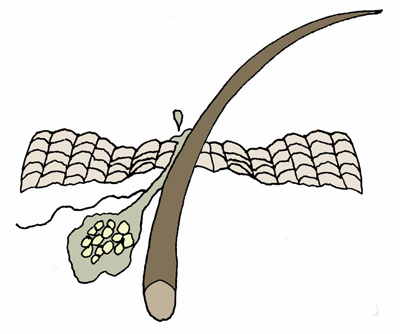 Every hair has a sebaceous gland nearby. Sebum oils your skin and keeps your scalp relatively waterproof so that the moisture inside your body does not evaporate and leave you dry and cracking. Some people produce a lot of sebum, some produce relatively less. If the outlet for sebum gets clogged with dirt or infected with microorganisms, it will plug up and become a pimple or cyst. |
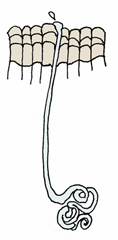 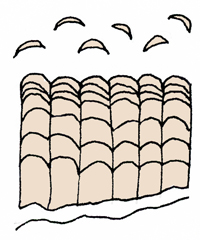 On the hairy parts of your body, you have sweat glands which get rid of metabolic waste. Sweat cools your skin with perspiration and leaves traces of your metabolic salts on the skin surface. Your body grows new skin cells every day which rise to the surface and are shed as they die off. It helps to remove the dead cells by massage, scrubbing, or detergent. Yeasts and other fungi just love to colonize the surface of your skin. Vinegar and henna will eliminate these microorganisms. These
salts include ammonia, potassium (0.2 g/l), calcium (0.015 g/l), and
magnesium (0.0013 g/l), and these can darken hennaed hair if not
removed by chelation. Ancient SunriseŽ Rainwash can reverse darkening from perspiration.
|
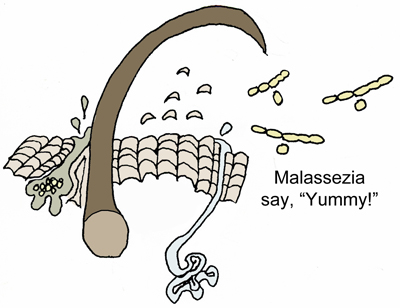 Your scalp is a biosphere of skin, living and dead skin, perspiration, sebum, and the microorganisms that live, eat, excrete, and die on your scalp. Some microorganisms are harmless. Some are not. Your scalp is a complex living biome that must be regularly cleaned and tended like every other part of your body if you do not want waste products to build up. Your scalp is alive, grows, sheds dead cells, and can be colonized by microbes. Your salty, oily dead skin flakes are as attractive as nachos to malassezia microorganisms (dandruff). |
Your fingers, and toes are living tissue. You clean your hands and feet frequently because the microorganisms that live on them
would love to have the opportunity to get inside your body and cause an
infection. You should keep your scalp clean for the same reason.
If a person
told you it was not necessary to wash your hands or feet because hands and feet gradually adapt to
the dirt, and that was only necessary to apply lotion from time to time, would you trust them to cook your lunch?
Your hair is not alive, just as your fingernails and toenails are not alive. You can cut your hair as much as you wish and it will not bleed, just as if you cut your fingernails and toenails, they will not bleed ... unless you cut down into the living tissue. The challenge is to keep your hair from being damaged while you regularly clean the debris from your scalp. If you want long hair, the objective is to keep hair from damage, dessication, and breakage. Your hair does not need the same kind of cleaning and tending as your scalp because once the hair exits the skin, it cannot repair damage to itself, just as your fingernails will not repair is you chip them. Water is an important part of cleaning your skin, but moisture can damage to hair if it is stretched or pulled when wet. This is the paradox of trying to keep your hair clean. |
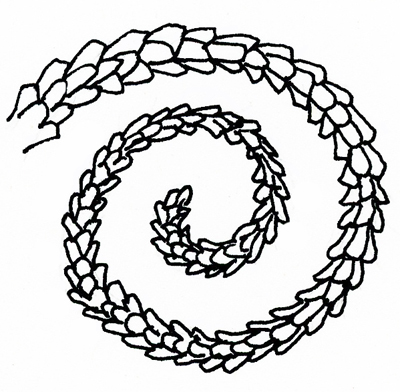 Hair has overlapping scales (like a tree trunk) that surround and protect the cortex which contains the melanin pigment color of hair. Some hair is more easily damaged because of its structure. Tightly coiled hair is easily stressed and broken, straighter hair. Some people produce fragile hair, some produce robust hair. A single hair grows an average of seven years before it becomes dormant, is shed, and begins to regrow. |
The
structure of hair is relatively solid when it first grows from the
scalp. The longer it grows, the more the hair weathers, like a rope
left outside. Hollow tubular spaces form in the cortex of the
hair as it
grows out. The older the section of hair, the more likely there
is to
be damage to the hair.  Where hair has been stretched, pulled, abraded, exposed to chemicals, particularly lighteners and oxidative hair dye, the cuticle and cortex may be damaged and the hair becomes fragile, then breaks. 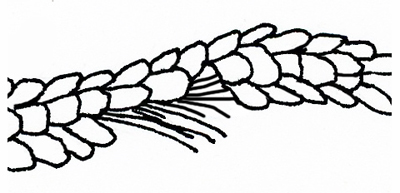 If a person wants to have long hair, that person should do things that prevent environmental, chemical, and stress damage to the hair. Avoid moisturizing, heating, combing while wet, UV and oxidative chemicals. |
 How do you clean your scalp (a living system) while keeping your hair (a non-living keratin fiber) undamaged? Some people do well to just shampoo with detergent because their scalp produces strong hair with plenty of sebum to keep the hair slightly oiled. |
 Some people do well to shampoo their hair with a fully fatted shampoo bar made with pure plant oils and butters which contain a free radical so they will rinse clean with water. This will leave a little bit of plant oil on the surface of the hair, protecting the moisture within the hair. Other people occasionally do an oil treatment on their hair. Ancient SunriseŽ fully fatted shampoo bars are HERE: and HERE |
 Hair can also be protected from dessication and damage by a thin layer of wax. The leaves of desert plants, as well as succulents and cacti, often have a waxy surface that prevents dessication. This sort of wax can protect your hair from drying out just as it protects the leaves of plants growing in the desert from drying out. Zizyphus Spina Christi leaves have a waxy surface as well as containing four saponins: molecules which will break up sebum, perspiration and dirt as does soap. Do you want to completely get away from detergents, artificial fragrances, and clean your scalp and hair with only pure powdered leaves? You can do this with Zizyphus Spina Christi! Purchase Ancient SunriseŽ Zizyphus spina christi HERE. |
Learn more about Zizyphus Spina Christi HERE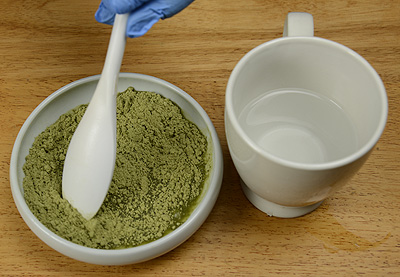 |
 When hair feels rough and damaged, we interpret this as "dry" and think the best thing to do is to "moisturize and condition". This may not actually be helpful if the conditioner contains glycerols, or other hygroscopic chemicals. (Hygroscopic means it attracts water.)  Water (and even humid days) makes hair temporarily stretchy, in the same way that getting good leather suede shoes or gloves damp stretches and damages them. If you have a conditioner on your hair that attracts water from the surrounding air, you make the hair more vulnerable to stretching and damage If you are having lots of difficulty with tangling, consider rinsing your hair with vinegar. This seems to make a comb glide through hair more easily. Braiding can help you manage your scalp health and hair length. Braid your hair before you shampoo, then concentrate on massaging and cleansing your scalp. Then, rinse your scalp and braid with vinegar. When your hair is dried, unbraid your hair and brush it out. Your hair will be deliciously wavy from the braid, and you will not loose much from breakage Combs made from water buffalo horn (keratin) are especially gentle on hair and do not cause static electricity to form. Ancient SunriseŽ has some beautiful wide-toothed combs HERE: |
Some
people think that hennaing your hair make it rough, coated, damaged,
and will ruin it and that acidic mixes are bad. That is misinformation;
here's what really happens:  When you apply henna paste to your hair, the scales plump up a bit, just as your fingertips start to look like a prune when you have been swimming for hours. The hydrogen rich (acidic) mix is not hurting your hair, but it does facilitate the uptake of the intermediate henna dye molecule.  When you rinse out the henna paste, the keratin scales are still plump, and they are full of lawsone molecules. The hair may feel rough to touch, but that is not because your hair is dried out. Do not panic. Be patient.  In a few days, those scales all settle down, and the lawsone molecules oxidize. Once this happens, your hair will feel smooth and strong. Henna protects your hair from dessication, so you probably will need less, or even no conditioner or oiling if you henna your hair. |
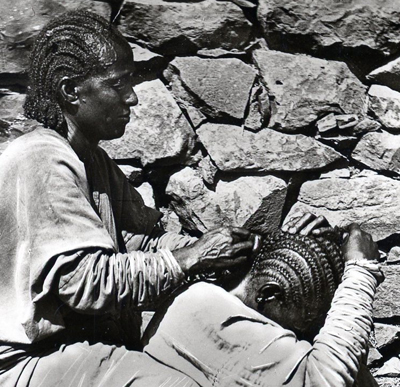 |
 The braid above is my own hair when I had it hennaed, and it had grown to knee length. I usually braided it before I shampooed it. I cleaned my scalp, then rinsed the suds through my braid and allowed my hair to dry braided. Most of the time I left my hair in the braid, then pegged it up into a bun. Braiding hair, one way or another, is one of the most straightforward things you can do to solve the problem of keeping your scalp clean while minimizing damage to your hair, unless you braid it too tight. Tight braiding can cause traction alopecia from extremely tight, stressful, scalp pulling breakage. North African petroglyphs show that people have valued the usefulness of braiding to manage healthy scalp and hair since the last ice age; people have have done so earlier! |